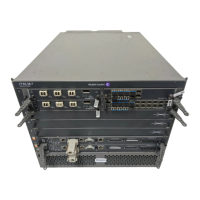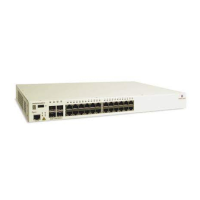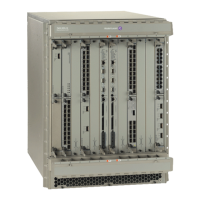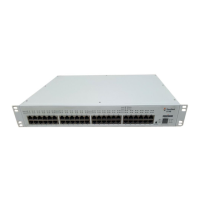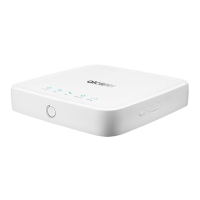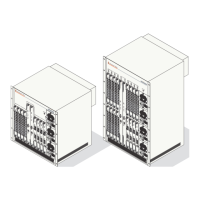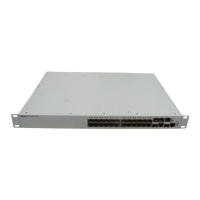Do you have a question about the Alcatel 1850 TSS-320 and is the answer not in the manual?
Provides initial details and context about the document.
Outlines requirements for authorized personnel performing installation and service.
Highlights the importance of adhering to safety instructions and local regulations.
Introduces the 1850 TSS-320, its evolution and key architectural concepts.
Explains the mechanical design drivers, backpanels, shelf structure, and slot concepts.
Lists and codes the items and units that make up the Equipment Shelf, including names, acronyms, and sizes.
Provides a block diagram of unit types and their general operating functions, covering EC320 and UNIVERSAL MATRIX.
Explains the flexible system design for TDM and data traffic management using a payload-independent switching element.
Describes the two-level control architecture, including First Level Controllers (FLC) and Second Level Controllers (SLC).
Outlines protection mechanisms like EPS, SNCP, MS-SPRING, and Drop & Continue.
Explains the timing function characteristics for clock generation and distribution.
Describes the power distribution system from the Top Rack Unit (TRU) to shelves and boards.
Details the EC320 board's functions, components (main and daughter boards), and hardware resources.
Covers the MT320 unit's capabilities for SDH and data switching, including Hmatrix, Lmatrix, SC, CRU, and power supply.
Covers the POW320 unit's role as an interface for battery input and auxiliary voltage supply.
Describes the FAN unit's function, power supply, performance, and control mechanisms.
Lists general application types and optical line bit rates for SDH, DATA, and CWDM.
Details optical safety compliance with European norms, hazard levels, and labelling requirements.
Covers electrical safety compliance with norms and labelling, including connection status.
Provides input voltage, current, interface standards, and power consumption for different configurations.
Details unit alarms, centralized equipment alarms, rack lamps, remote alarms, and housekeeping alarms.
Covers EMC norms, WEEE, acoustical noise, climatic conditions, storage, and transportation requirements.
Provides essential safety rules and warnings for handling equipment, including optical and electrical hazards.
Provides general guidelines for easy disassembly using screws and rivets, optimizing material recovery.
Lists hazardous materials and components present in the equipment, indicating their presence and location.
Provides instructions for first aid in case of electric shock, including artificial respiration and burn treatment.
Outlines general safety rules for installation, operation, maintenance, and handling of equipment.
Explains EMC norms and provides general rules for installation, turn-up, operation, and maintenance.
Details precautionary measures for handling electrostatic sensitive devices, including antistatic protection devices.
Relates reference numbers from figures to specific labels affixed to the equipment, aiding identification.
Details the contents, creation, use, and identification of customer documentation provided on CD-ROM.
Lists handbooks related to hardware, including part numbers and references to the current manual.
Lists handbooks pertaining to local product software management, including operator's handbooks.
Lists common handbooks relevant to the 1850 TSS-320, such as operator's and technical handbooks.
Lists the documentation available on CD-ROM, referencing specific handbooks included.
Provides initial details and context about the document.
Outlines requirements for authorized personnel performing installation and service.
Highlights the importance of adhering to safety instructions and local regulations.
Introduces the 1850 TSS-320, its evolution and key architectural concepts.
Explains the mechanical design drivers, backpanels, shelf structure, and slot concepts.
Lists and codes the items and units that make up the Equipment Shelf, including names, acronyms, and sizes.
Provides a block diagram of unit types and their general operating functions, covering EC320 and UNIVERSAL MATRIX.
Explains the flexible system design for TDM and data traffic management using a payload-independent switching element.
Describes the two-level control architecture, including First Level Controllers (FLC) and Second Level Controllers (SLC).
Outlines protection mechanisms like EPS, SNCP, MS-SPRING, and Drop & Continue.
Explains the timing function characteristics for clock generation and distribution.
Describes the power distribution system from the Top Rack Unit (TRU) to shelves and boards.
Details the EC320 board's functions, components (main and daughter boards), and hardware resources.
Covers the MT320 unit's capabilities for SDH and data switching, including Hmatrix, Lmatrix, SC, CRU, and power supply.
Covers the POW320 unit's role as an interface for battery input and auxiliary voltage supply.
Describes the FAN unit's function, power supply, performance, and control mechanisms.
Lists general application types and optical line bit rates for SDH, DATA, and CWDM.
Details optical safety compliance with European norms, hazard levels, and labelling requirements.
Covers electrical safety compliance with norms and labelling, including connection status.
Provides input voltage, current, interface standards, and power consumption for different configurations.
Details unit alarms, centralized equipment alarms, rack lamps, remote alarms, and housekeeping alarms.
Covers EMC norms, WEEE, acoustical noise, climatic conditions, storage, and transportation requirements.
Provides essential safety rules and warnings for handling equipment, including optical and electrical hazards.
Provides general guidelines for easy disassembly using screws and rivets, optimizing material recovery.
Lists hazardous materials and components present in the equipment, indicating their presence and location.
Provides instructions for first aid in case of electric shock, including artificial respiration and burn treatment.
Outlines general safety rules for installation, operation, maintenance, and handling of equipment.
Explains EMC norms and provides general rules for installation, turn-up, operation, and maintenance.
Details precautionary measures for handling electrostatic sensitive devices, including antistatic protection devices.
Relates reference numbers from figures to specific labels affixed to the equipment, aiding identification.
Details the contents, creation, use, and identification of customer documentation provided on CD-ROM.
Lists handbooks related to hardware, including part numbers and references to the current manual.
Lists handbooks pertaining to local product software management, including operator's handbooks.
Lists common handbooks relevant to the 1850 TSS-320, such as operator's and technical handbooks.
Lists the documentation available on CD-ROM, referencing specific handbooks included.
